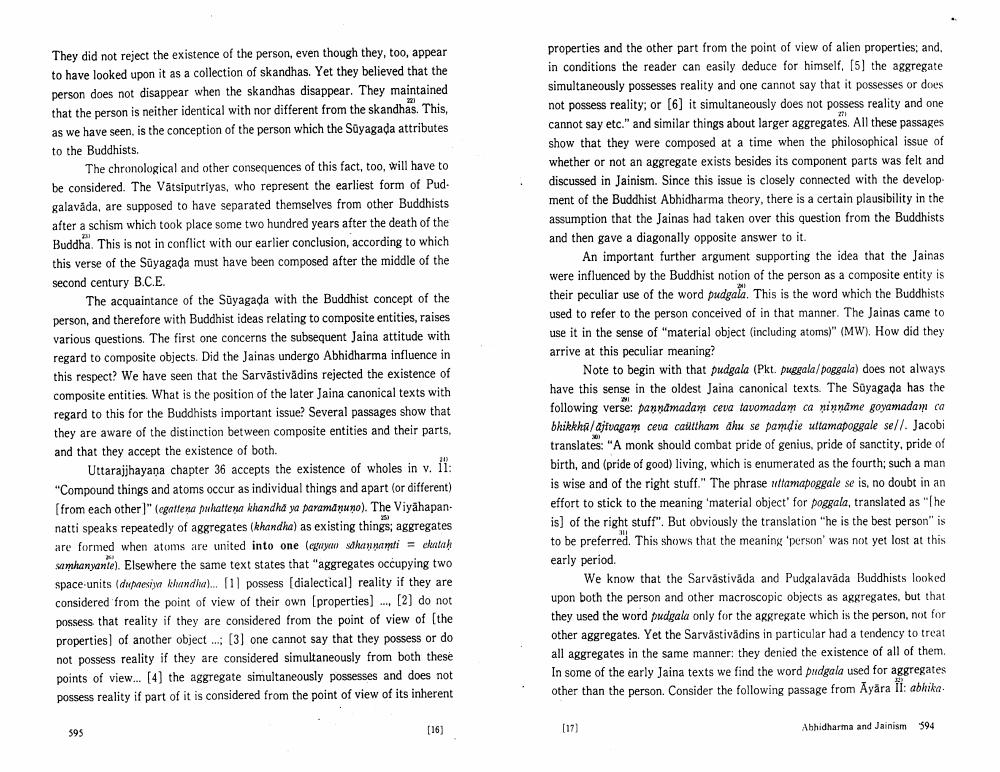________________
They did not reject the existence of the person, even though they, too, appear to have looked upon it as a collection of skandhas. Yet they believed that the person does not disappear when the skandhas disappear. They maintained that the person is neither identical with nor different from the skandhas. This, as we have seen, is the conception of the person which the Söyagada attributes to the Buddhists.
The chronological and other consequences of this fact, too, will have to be considered. The Vätsiputriyas, who represent the earliest form of Pudgalavāda, are supposed to have separated themselves from other Buddhists after a schism which took place some two hundred years after the death of the Buddha. This is not in conflict with our earlier conclusion, according to which this verse of the Süyagada must have been composed after the middle of the second century B.C.E.
The acquaintance of the Süyagada with the Buddhist concept of the person, and therefore with Buddhist ideas relating to composite entities, raises various questions. The first one concerns the subsequent Jaina attitude with regard to composite objects. Did the Jainas undergo Abhidharma influence in this respect? We have seen that the Sarvāstivādins rejected the existence of composite entities. What is the position of the later Jaina canonical texts with regard to this for the Buddhists important issue? Several passages show that they are aware of the distinction between composite entities and their parts, and that they accept the existence of both.
Uttarajjhayana chapter 36 accepts the existence of wholes in v. 11: "Compound things and atoms occur as individual things and apart (or different) (from each other" (egattena puhattena khandha ya paramdnano). The Viyahapan natti speaks repeatedly of aggregates (khandha) as existing things; aggregates are formed when atoms are united into one guy shari = katah semhanyante). Elsewhere the same text states that "aggregates occupying two space units (dwesir khandhal... 111 possess dialectical) reality if they are considered from the point of view of their own (properties) ... [2] do not possess that reality if they are considered from the point of view of the properties of another object ... [3] one cannot say that they possess or do not possess reality if they are considered simultaneously from both these points of view... [4] the aggregate simultaneously possesses and does not possess reality is part of it is considered from the point of view of its inherent
properties and the other part from the point of view of alien properties; and, in conditions the reader can easily deduce for himself. (5) the aggregate simultaneously possesses reality and one cannot say that it possesses or does not possess reality, or [6] it simultaneously does not possess reality and one cannot say etc." and similar things about larger aggregates. All these passages show that they were composed at a time when the philosophical issue of whether or not an aggregate exists besides its component parts was felt and discussed in Jainism. Since this issue is closely connected with the develop ment of the Buddhist Abhidharma theory, there is a certain plausibility in the assumption that the Jainas had taken over this question from the Buddhists and then gave a diagonally opposite answer to it.
An important further argument supporting the idea that the Jainas were influenced by the Buddhist notion of the person as a composite entity is their peculiar use of the word pudgala. This is the word which the Buddhists used to refer to the person conceived of in that manner. The Jainas came to use it in the sense of "material object (including atoms)" (MW). How did they arrive at this peculiar meaning?
Note to begin with that pudgala (Pkt. puggala/poggala) does not always have this sense in the oldest Jaina canonical texts. The Sayagada has the following verse: pannamadam ceva tavomadam ca ninname goyamadam ca bhikkha/astuagam ceva caittham āhu se pandie ultamapoggale sell. Jacobi translates: "A monk should combat pride of genius, pride of sanctity, pride of birth, and (pride of good) living, which is enumerated as the fourth; such a man is wise and of the right stuff." The phrase uttamapoggale se is no doubt in an effort to stick to the meaning 'material object' for poggala, translated as "The is) of the right stuff". But obviously the translation "he is the best person" is to be preferred. This shows that the meaning person was not yet lost at this early period.
We know that the Sarvāstivada and Pudgalavada Buddhists looked upon both the person and other macroscopic objects as aggregates, but that they used the word pudgala only for the aggregate which is the person, not for other aggregates. Yet the Sarvāstivādins in particular had a tendency to treat all aggregates in the same manner: they denied the existence of all of them. In some of the early Jaina texts we find the word pudgala used for aggregates other than the person. Consider the following passage from Ayara II: abhiky:
595
(16)
(17)
Abhidharma and Jainism
594




